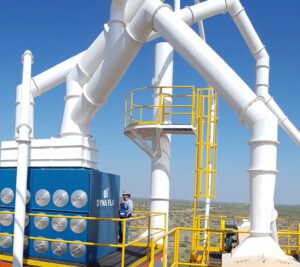ahorro de energía

BLOG
Industrial collectors and energy saving in the company
One of the most frequent doubts, on the part of the directors of the company before investing in a ventilation system such as Industrial Dust Collectors is, How much energy will it consume? Will I be able to save energy and therefore money?
In order to justify the investment in an Industrial Collector for the control of dust, fumes or mists, the heads of the Engineering and Projects departments must carry out a detailed analysis of the current complications in the operation and expose the benefits of the equipment that is required. .
For this, they must work hand in hand with us, the experts in industrial ventilation systems, which we have the experience and knowledge necessary to help them choose the industrial collector that can solve in the most efficient way their problems of dust control, this It will allow executives to justify the investment in this type of equipment.
How to justify the investment in a Dust Collector?
There are two fundamental factors that will conserve energy and therefore save:
- Selecting the proper size dust collection system will help minimize amperage consumption.
- Recirculate the filtered air, this will help improve performance and therefore reduce energy consumption.
If the engineering work is done correctly, this will reduce the power required in the dust collector, helping to reduce energy costs on an annual basis.
At Grupo Oasis, we develop your project from start to finish, we have specialized personnel to find the best solution for your company. Call us!

Ductwork and hood design
Undoubtedly, having specialized personnel for the design of the complete equipment, manufacture and its implementation is the best option, thereby guaranteeing optimal performance. The following should also be considered:
- One of the ways to reduce energy consumption is with the proper design of the hoods and a good job of the ductwork. For example, a good design of suction hoods would be located near the point where emissions are generated, thereby reducing air requirements and, in turn, reducing the size of the collector and fan as a consequence of HP's and amperages. necessary.
- Another could be, the design of a geometrically improved conical bell, this generates less turbulence and therefore the resistance is lower than in a direct bell.
- Minimize the use of flexible hoses, this will reduce the motor power requirements on the fan. Flexible hoses have higher losses associated with static pressures generated by the interior roughness of their design and the radii that are generated during their installation.
- The optimization of the duct system, with secondary inlets of 30 ° instead of 60 °, radii at the elbows of 2 diameters instead of 1-1.5, will also reduce the requirements to overcome the static pressure of the system.

Input / output configuration
- Another method that helps reduce power requirements is by improving the intake to the collector, as well as the intake and discharge of the fan.
- A 30 ° expansion inlet to the manifold will save static pressure and consequently power compared to a direct inlet.
- Wrong fan inlets and inlet elbows result in increased power consumption.
- Without a duct section at the fan discharge the static pressure increases increasing power requirements to overcome turbulence at the fan outlet.
DYNA FLO® Tips:
- Before designing a dust control system, consult with us.
- Consider the maintenance of your collectors in your budgets.
- Take into account the opinion of the operators for the design of the collectors.
Collector Types
ahorro de energía
Other articles of interest

Axial or Centrifugal Fans
To be able to move large volumes of air through a ventilation system or localized extraction system, in the vast majority of cases it is necessary to apply a lot of energy and this regularly comes from the fans, although in some cases it can also be applied as natural form.

What type of industrial ventilation system do I need for my company?
Ventilation systems are used to ventilate closed spaces in the industrial or commercial sector, their function is to regulate the temperature, renew the air, extract dust, smoke, mist or gases, prevent…

Filtration speed
It can be defined as the proportion of air that passes through the filter cloth, that is, the amount of air that passes through each square foot of the filter media area per minute.






